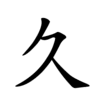久
See also: 乆
| ||||||||
Translingual
| Stroke order | |||
|---|---|---|---|
| Stroke order | |||
|---|---|---|---|
 | |||
Han character
久 (Kangxi radical 4, 丿+2, 3 strokes, cangjie input 弓人 (NO) or X弓人 (XNO), four-corner 27800, composition ⿸𠂊㇏)
Descendants
- く (Hiragana character derived from man'yōgana)
- ク (Katakana character derived from man'yōgana)
- 𛀫 (Hentaigana)
- 𛀬 (Hentaigana)
References
- KangXi: page 81, character 19
- Dai Kanwa Jiten: character 118
- Dae Jaweon: page 165, character 6
- Hanyu Da Zidian (first edition): volume 1, page 33, character 3
- Unihan data for U+4E45
Chinese
| simp. and trad. |
久 | |
|---|---|---|
| alternative forms | 乆 𫝄 | |
Glyph origin
| Historical forms of the character 久 | |||||||||||||||||
|---|---|---|---|---|---|---|---|---|---|---|---|---|---|---|---|---|---|
| |||||||||||||||||
|
References: Mostly from Richard Sears' Chinese Etymology site (authorisation),
|
Characters in the same phonetic series (久) (Zhengzhang, 2003)
Pictogram (象形) - a man receiving moxibustion. The derivative 灸 (OC *kʷlɯʔ, *kʷlɯs) refers to the original word.
Etymology
Possibly Sino-Tibetan. Compare Bantawa [script needed] (kʰokpa, “old man”) (Sagart, 2017d), which STEDT derives from Proto-Sino-Tibetan *kwak (“old”).
舊 (OC *N-kʷəʔ-s) may be a derivative (Baxter and Sagart, 2014). See there for more.
Pronunciation
Definitions
久
Synonyms
Dialectal synonyms of 久 (“long (time)”) [map]
Compounds
Derived terms from 久
|
|
|
Japanese
Readings
Vietnamese
Han character
References
- Bonet (1899).
- Taberd & Pigneau de Béhaine (1838).
- Trần (2004).
- Génibrel (1898).
This article is issued from Wiktionary. The text is licensed under Creative Commons - Attribution - Sharealike. Additional terms may apply for the media files.
















